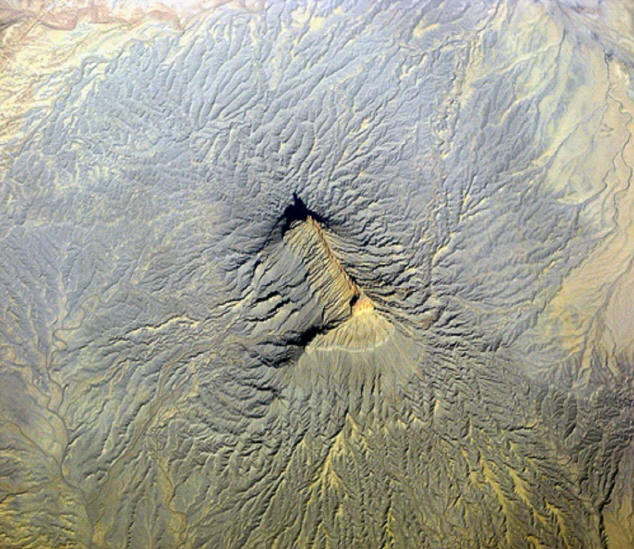Craters and Buttes Part Two
Dec
04, 2009
Craters often have flat bottoms
and forty-five degree slopes. Buttes
often exhibit forty-five degree
shoulders and flat tops.
Crater morphology was discussed in
part one of this article. Meteor
Crater, Arizona was used to
illustrate various anomalies
associated with craters, in general.
Factors such as steep walls, flat
floors, and electrically induced
fulgurites (glassified
minerals) led to the conclusion that
craters on Earth result from
lightning strikes of incredible
violence. Lightning of strength
sufficient to excavate craters that
measure up to
100 kilometers in
diameter is no longer active on our
planet, although it might exist on
some of the Solar System's many
moons.
Something else that might have
been caused by past bursts of
intense plasma activity on Earth are
buttes, also called mesas, or
tepuis. How do craters
and buttes relate to one another as
the children of catastrophic
parentage? Could the same force
excise holes in the ground, as well
as pile up giant mounds of material,
transmogrifying them into
layered mountains adorned
with embossed Lichtenberg figures as
seen in the image at the top of the
page?
A fulgamite, or lightning
blister, develops when an electric
discharge pulls charged material
from the surrounding area,
incidentally dragging the neutral
matter with it. A large enough
electric arc will act like an
enormous plasma tornado, with an
extremely low pressure region in the
center enclosed by powerful
electromagnetic fields. It is this
central vortex that can exert forces
that
crush and melt dust and
other substances until they become
stone.
The most notable fulgamite in the
Solar System, apart from the largest
one,
Olympus Mons, is probably
the “face on Mars.” Another, except
found on Earth, is the
Brandberg Massif.
As Electric Universe theorist
Wal Thornhill wrote:
"An arc struck to an anode tends
to 'stick' in one place, causing
much melting and often raising a
circular blister, called a fulgamite.
Fulgamite scars on lightning
arrestors are bell-shaped with a
circular crater, or craters, at the
summit. They often rise steeply from
a circular depression or 'borrow
pit,' with many rings. This should
sound familiar to any keen observer
of Mars. Olympus Mons has all of
these strange features, which do not
fit the volcano model. The giant
volcanoes on Mars are in fact
massive fulgamites!"
No one knows how lightning might
behave when it is scaled up to
continental or planetary dimensions,
since activity on that level has
never been observed. However, the
forensic evidence left behind on
Earth, Mars, the Moon, and every
other rocky body in the Solar System
seems to indicate that it will do
the same thing that it does when it
is tamed and confined in laboratory
plasma experiments.
Mars is a desiccated wasteland,
preserved in a low pressure
deep-freeze. The winds that blow
there might move at over 100
kilometers per hour, but the
atmosphere is so thin that the dunes
found on the vast desert world might
be transported a meter every
thousand years. The Mars Exploration
Rovers can "feel" no wind, only the
gentlest breath of a breeze.
Therefore, no erosion issues are
present to disguise the effects of
past electrical scarring on its
surface.
A particular kind of crater found
on Mars is called a "rampart
crater."
Rampart craters are found
on top of upraised,
wide stoney formations
that have vertical walls. In many
cases, they have
central mountain peaks
similar to those that are commonly
seen on Earth's Moon. In other
cases, the center of the crater is
dominated by oddly shaped
scallops cut into the
floor that crisscross one another.
Mars might be the best place to
look for the signs of electricity's
"pulling" force. There are regions
covering thousands of square
kilometers where giant mounds of
loose regolith have been turned to
stone and then had their summits
ripped out
almost down to bedrock, leaving
conical shells.
Perhaps all craters are
fulgamites with their tops
electrically eroded. Depending on
the power, an electric arc might
leave the fulgamite intact before
leaping upward to complete a circuit
with whatever it was that initiated
the leader stroke. In that instance,
there will be no crater on top.
Electric Universe pioneer
Ralph Juergens
explained the structure of Tycho
Crater on the Moon in electrical
terms:
"The visual evidence suggests
that triggering electrons for the
Tycho discharge were assembled by
means of an atmospheric-breakdown
process that drew them from numerous
distant points in all directions and
hauled them over the surface to a
common collection point. On the far
side of the Moon are several more
long-rayed craters, presumably
marking sites where much the same
thing happened; these, too, are
located in highland terrain."
A plasma leader stroke descending
towards the surface of a planet
might cause oppositely charged rocks
and sand to gather from hundreds of
kilometers, leaving Lichtenberg
trackways that point to where a
secondary return stroke is building
up, awaiting a discharge trigger. As
the electric current flow reaches up
to meet the leader stroke, the
materials mound up, but being
similarly charged, create repulsion,
so the mound will be loosely formed
at first.
When a certain critical threshold
is reached, the two electric
filaments meet and the secondary
stroke jumps upward, pulling the
center of the mound out with it,
excavating it like a rotating auger
of fire. The reason that craters
have raised rims is that they are
all that remains of the original
mound of loose material. Once the
discharge occurs, thermal and
magnetic effects fuse the remnants
into solid stone.
Stephen Smith
|







